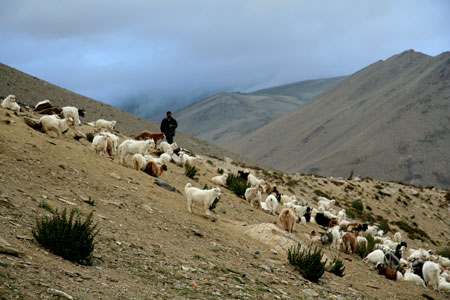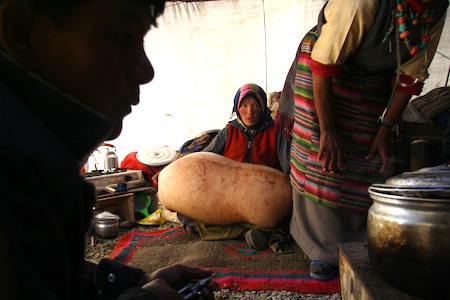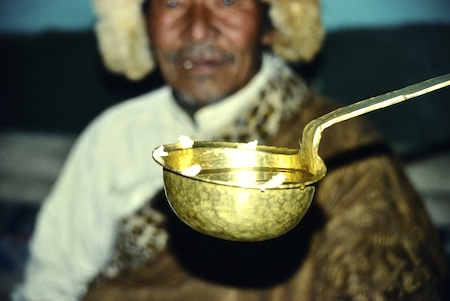Culture
Milk, gods and mountains...

Mountain Gods
In the villages and camps, it is said that mountains to be living creatures, which can move, and which actually do not hesitate to shift to another location or embark upon long travels, for example to marry other mountains.
They are associated to gods, fierce war-gods whose protection is actively seeked. Therefore, these mountain-gods are the object of a cult from the communities living near by, these communities becoming the keepers of the place, under the protection of the divinity.
The arrival of buddhism has modified this custom: the local gods have been replaced by buddhist saints, and as a result, the worship sites jealously kept by the inhabitants of the region became pilgrimage destinations attracting believers from all over Tibet.
Nowadays, the most renowned of these holy mountains is Mount Tise, also called Kang Rimpoche, but more famous under its indian name: Kailash. Located in south-west Tibet, in the Ngari region, Mount Kailash attracts not only tibetan pilgrims but also indians of hindu and jain denomination, Kailash being a holy mountain for them too.
The Yeti
Called "demong" in western Tibet, the yeti is one of the most famous aspects of tibetan culture.
Tibetans explain that there are two types of yeti: those with a hairy face only eat animals; those with a hairless face are more dangerous since they do not hesitate eating human flesh.
Very clever, the yeti can set traps to his victims: for example by standing on a height, with a dry yak dung on his head as a hat, waving his arm to invite the traveler to come close. From the distance, the illusion is deceptive : the yeti can easily be mistaken for a welcoming human wearing a hat.
In case of an attack by a yeti, one should always run downwards, tearing down the slopes: that way, the yeti is hampered by his abundant hair which falls in front of his eyes and slows down his progress.
A human being caught by a yeti does not necessarily end up devoured. If a female yeti captures a man, she will prefer to keep him as her husband. He will have to mate her and live in the mountain with his new family for the rest of his life. It is said that some have managed to escape. The same thing happens when a male yeti captures a woman.
The yeti has an important position in the tibetan imagination, which reminds of the role of the bear in the ancient cultures of Europe.
Refugees in Ladakh say they have seen a yeti wandering about in the surroundings of Choglamsar, in the yet very populated Leh valley.

Tea, barley and butter
Tibetans drink tea all day long. Their tea could rather be called soup, since, to the tea and hot water, they add a surprising quantity of salt and butter. All tibetans take great delight in this beverage, and this is one of the points which surely distinguishes them from other peoples.
The other cultural trait specific to tibetans as a whole is tsampa, roasted barley flour, which is their staple diet. Tsampa is most often mixed with butter tea, which produces a sort of mash to be eaten with the finger, and in which cheese is sometimes melted.
Tibetans prepare a delicious liquid yoghourt, which they like to thicken with tsampa. Butter is produced in large quantities : consumed throughout the day in tea, it also serves to prepare tibetan cheese, which generally takes the shape of white nuggets as hard as stones. Butter is also used to feed the small lamps lit for the gods every night in hundreds of thousands all over Tibet. It is also used in the temples for the carving of spectacular multicoloured sculptures entirely made of butter.
Buddhists have never tried to impose vegetarism in this land of animal rearing where vegetables grow so scarsely. Hence meat is abondantly eaten, mainly as stew, willingly accompanied by black radish.
In Lhassa and especially among the aristocracy, several chinese dishes were very popular, such as ravioli, noodles soup and fried noodle, which became very common among the exile community.
Though some areas of the south used to produce white wine, the main tibetan alcohol remains chang, a barley beer.
Beliefs
The tibetan religion is a syncretism gathering elements from himalayan animism, astrology, bön, shamanism, buddhism, mountain cult and polytheism.
An important part of the religious beliefs and practices is extremely ancient and dates back from the dawn of tibetan history : it is the case for example of the invocations to the gods ("kiki sosso lhagyalo"), the throwing of tsampa, the juniper fumigations, the possession rituals, the food offerings, etc...
Like christianity in Europe, buddhism had, in order to become established, to take into account the local customs, and adapt its rites to the tibetan traditions.
Within the monastic community exists a more theoretical buddhism, which has little in common with tibetan local customs, hence being more universal. Therefore, this intellectual buddhism has been for several decades enjoying some success abroad.
